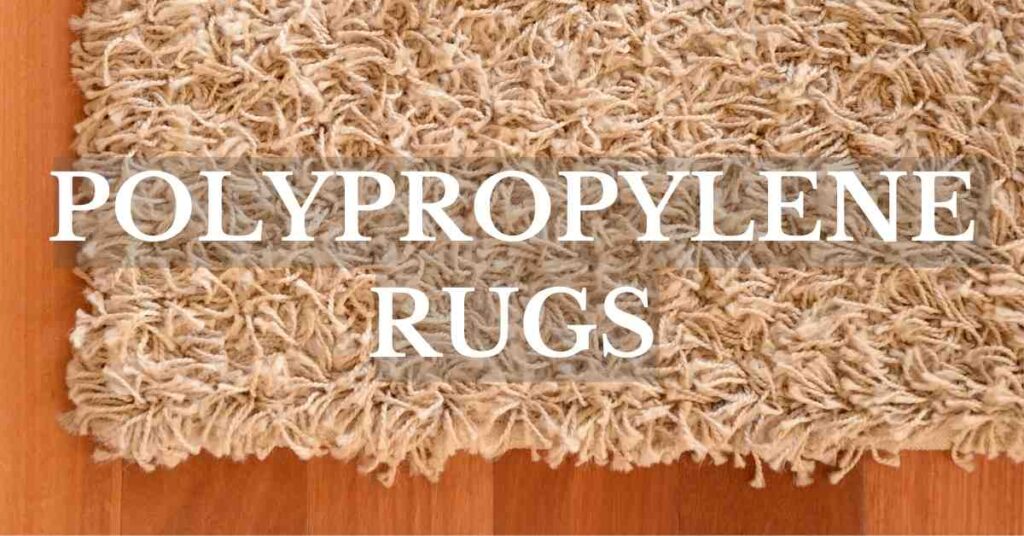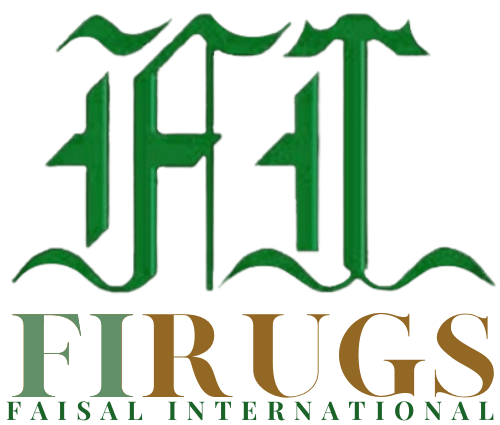
Table of Contents
Indoor Outdoor Polypropylene Rugs
“Polypropylene rugs” are made from synthetic fibers and are machine-made, braided, and woven. Since synthetic fibers are artificial and specially designed for making carpets, they stand the test of time. Polypropylene outdoor rugs are also easier to wash and dry because they don’t absorb much water.
What's Inside!
In this article, we cover everything you need to know about Polypropylene made rugs. Are polypropylene rugs safe? What are the health risks? Are they toxic? The article also includes:
- Some popular polypropylene indoor outdoor rugs online
- Polypropylene vs polyester rugs
- Polypropylene vs wool rug
- Polypropylene pros and cons
- Cleaning polypropylene rugs
- Care and maintenance
What Are The Benefits Of Polypropylene Rugs
The advantages of polypropylene fiber rugs far outweigh their disadvantages. Indoor/outdoor polypropylene rugs are virtually fade resistant and resist moisture and mold. And as attractive as they are, they are still inexpensive!
Polypropylene carpets have enough features to compliment them. Probably the main one is its suitability for use in exterior or interior / exterior applications. Let’s see some of its advantages.
1. Durable
Polypropylene carpets and rugs are durable, color and stain-resistant. If they are professionally cleaned regularly, synthetic rugs are expected to last 4 to 6 years on average.
What makes them more demanding is their weather resistance; hence are ideal for outdoors. Polypropylene is resistant to soaking and, if air-dried, will resist mold and mildew growth. However, if not allowed to dry, the fiber will develop these unwanted things like anything else.
2. Affordable
Rugs of this kind tend to be very cheap and are readily available in any carpet store. You can pick from many different styles and colors. So you are likely to find one that is suitable to match or complement a particular pattern that you prefer, such as a southwestern style.
3. Colorfastness
Colorfastness is one of the significant benefits of polypropylene fabric rugs. Other carpet fabrics are usually dyed, but not polypropylene! You get the colors in them in the manufacturing process, and therefore the fabric itself is the color and will not fade over time like other colored fabrics.
4. Stain Resistant
The high resistance to staining is another reason why polypropylene fiber rugs are so popular. Petroleum-based dyes tend to release colorants that are not oil-based.
So are regular and thick polypropylene rugs waterproof? Yes, they are waterproof as they do not absorb water, making them practically resistant to stains (except for oil-based products) and easy to clean.
Although rugs are typically placed at the entrances to a home’s main living area, they are not suitable for garage entrances because they tend to absorb oil-based stains.
5. Easy To Clean And Maintain
If your outdoor carpet has been maintaining your outdoor flooring for a long time, all you need is soap and water to make it look good, shiny, and new again. Nonetheless, it is an excellent addition to most exterior entrances.
You’ll get all the dirt out of your house this way. Since they are entirely washable without fear of discoloration, they can be machine washed, thoroughly dried, and then put back into service.
6. Variety
Popular choices include various patterns and designs, such as Persian-themed rugs, Oriental rugs, and Tibetan rugs. A polypropylene rug also comes in different colors and can contain designs such as traditional animal designs, floral designs, and geometric variations.
Also, they can be based on the southwest pattern or have children’s rugs.
Best Polypropylene Rugs Reviews Online
Care And Maintenance
Below are a few ways to keep polypropylene outdoor and indoor rugs safe,
- Vacuum
If you want to make sure dust and mites don’t accumulate on your carpets, you need to vacuum regularly. Even tiny dust particles, when they accumulate on your carpets, can cause damage. They can cause respiratory problems and affect the quality of the carpet. - Liquid Spills
Be sure to clean up a spill from carpets immediately. Don’t wait for the guests to leave or for you to finish preparing dinner. Heal the spill quickly if you don’t want it to leave a stain. - Solid
If you have dropped the sauce with chicken pieces on the mat. Be sure to remove the solid pieces first to ensure the safety of the polypropylene rugs. - Stain Removal
Some stains can be stubborn and difficult to remove. Therefore, you will need the help of any stain remover available online. Make sure to use a good quality one that will not affect the safety of polypropylene rugs. - Stubborn Stains
If your carpet is an expensive variety and you are concerned about damaging it if you clean it yourself. Use the services of a dry cleaner to keep polypropylene rugs safe. - Color Damage
Many times, people take responsibility for cleaning rugs themselves. To clean, they use cleaning agents that can damage the color. It is best to call in an expert to make sure your precious carpet does not discolor.
Polypropylene Rug Cleaning Instructions
You must use this method on a scorching day so that your rug dries within less than 24 hours. You can make your cleaner by combining liquid detergent and fabric softener.
- Mix one-eighth of a cup of liquid laundry detergent with a quarter of a cup of fiber softener in a squeeze bottle. Mix in two cups of warm water and shake well to mix.
- Apply the prepared solution to the rug and hand scrub the entire rug.
- You then need to rinse the rug after scrubbing until you see no more detergent.
- Hang the rug on a fence or elevated place so that water drips out from the rug while still in the sun. Make sure that the rug gets sufficient sunlight by rotating it throughout the day.
Note: Dry your rug thoroughly. Else, it will negatively affect the rug as the rug will start turning yellow and may begin to smell.
Polypropylene Rugs Pros And Cons
PROs
- One of the cheapest fibers in the market.
- Except for oil-based stains, they are highly resistant to staining.
- Do not colorfast or fade away colors even under sunlight or bleach wash.
- It is easy, simple, and takes less effort to clean them.
CONs
- Polypropylene has low resilience and is prone to crushing.
- A major drawback is that they undergo processing with harmful chemicals.
- It is not ideal for placing in areas where there is high foot traffic.
- Oil-based stains are not easy to clean, so they are not the right fiber rug for dining rooms or kitchens.
Is Polypropylene Rug Safe For Babies?
Yes, they are safe for babies and also safe for your dogs and cats at home. However, polypropylene with low quality can be harmful. When it is about choosing a rug for babies, it is better to be more selective. We recommend you go for wool fiber rugs instead. Although wool is expensive, it has plenty of benefits over synthetic that even your babies and pets will love.
Children’s safety is increased with flame retardant polypropylene carpets, which do not melt, catch fire, or become heated too fast, so they cannot get burned.
On the other side, polypropylene being chemical treated releases VOCs and PBDEs that may harm your little one. If you are on a budget and wish to purchase a polypropylene one, do read the quality manuals of the fiber before purchase.
Is A Polypropylene Rug Toxic?
Top-quality polypropylene is safe to use as they are just plastic. Rugs made of polypropylene may have toxic byproducts that may cause some specific problems like nausea, allergies, headaches, or even dizziness when inhaled.
Polypropylene Rugs Vs Wool
Polypropylene fabric rugs have certain drawbacks, like all other types of carpets. Neither are they as strong nor soft as wool fiber rug nor luxurious. They will start to show wear and tear after a while, mainly if placed outdoors all year round.
They will stain oil-based materials because they are petroleum-based fibers. Besides being warmer and softer to the touch, wool rugs are more durable. And it won’t ignite as fast as olefin.
Below is a simple laydown of polypropylene vs wool rug to understand better.
DESIGN
Polypropylene: Polypropylene fiber made rugs usually have many amazing designs since they’re machine-made. They’re less detailed compared to wool made rugs.
Wool: You will find several creative designs in woolen rugs. It has a very detailed appearance and a lush aesthetic.
DURABILITY
Polypropylene: The lifespan is between 4 and 6 years. It is not the best rug for high traffic as it gets matted and crushed easily.
Wool: Most wool rugs can be heirloom quality and will last for generations if they are well cared for.
TEXTURE
Polypropylene: A polypropylene rug’s texture is stiffer than a wool one, but not in an intense way. They can feel a bit slippery to touch compared to wool.
Wool: Wool rugs are, by nature are bouncy and soft and velvety.
CLEANING
Polypropylene: It is easy to maintain but gets matted with each clean, which does not look as good as it was new. If baby or pet pee on these synthetic rugs is left uncleaned for a long time, it can leave a yellow stain on it.
Wool: Easier to clean. Needs professional cleaning at least once every 2-3 years. Simple to maintain by frequent vacuuming and spot cleaning.
USAGE
Polypropylene: Polypropylene fiber is water-resistant, so rugs made of them are ideal for the outdoors.
Wool: Wool rugs are best for indoor usage. The fiber is firm but not adaptable to the outdoor climate.
COST
Polypropylene: It takes less time to make polypropylene fiber rugs, so it costs far less than wool-made rugs.
Wool: Hand-knotted wool rugs are expensive because of their heirloom quality and durability. However, a hand-tufted wool rug with the same design cost less.
PILE
Polypropylene: Polypropylene rugs have a shallow pile – ranging from 0.35″ to 0.5″.
Wool: Pile height depends on the type of rug weave. Knotted and tufted wool rugs have a good pile. Dhurrie kilim or the flatweave do not have a pile. Shaggy wool rugs have long piles.
BACKING
Polypropylene: A polypropylene carpet does have a backing.
Wool: Authentic hand-knotted woolen rugs never have a backing. In contrast, tufted wool rugs typically have canvas backings.
HEALTH RISK
Polypropylene: Polypropylene is a synthetic fiber treated with chemicals. Moreover, the fiber is highly flammable.
Wool: Wool is a natural fiber, and they are safe to use as it has no chemical in them.
ECO-FRIENDLINESS
Polypropylene: Polypropylene fibers are not eco-friendly as they are petroleum made in laboratories.
Wool: Since wool rugs are natural and not treated with chemicals, they are eco-friendly and biodegradable.
Polypropylene Vs Polyester Rugs
- The luxurious, cozy quality of polypropylene is often said to mimic that of wool.
- Polyester rugs maintain their texture better than polypropylene fiber rugs, and they do not go out of sharp as quickly.
- Polyester is more absorbent than polypropylene, so it is best for household accidents.
- Compared to polyester, polypropylene dries closer to its original color and is less prone to mold over time.
- With either type of rug, stain removal is typically as simple as spot cleaning.
- Both are inexpensive, and neither fibers last more than three to five years, so you will never be tied to a single style.
BOTTOM LINE
It is not as soft and warm as other fabrics, but it’s stain resistance and ease to wash makes it the preferred choice for such an application. Polypropylene, which you probably know best as olefin, is an excellent synthetic fiber for carpets.
These fabric carpets are ideal for high traffic areas, rooms with frequent spills (such as bathrooms, gaming rooms, nurseries, kitchens and outdoors.
Polypropylene rugs are machine-made, they’re affordable, colorfast, and amazingly, they manage to feel smooth and attractive while doing it all.
